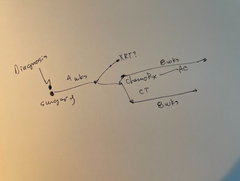Introduction
Hormone-positive breast cancer means that the cancer cells are influenced by estrogen and progesterone hormones produced in the body. This type of breast cancer often responds well to treatments that interfere with the growth signal these hormones provide. For many women on hormone blocking medicine (such as aromatase inhibitors) during breast cancer treatment, joint pain can be a side effect. These medications, while effective against cancer, might lead to discomfort in the joints. During my time on a hormone blocking drug, I definitely experienced joint discomfort, usually in the form of stiffness. My young daughters would often ask me, “Mommy, why are you walking like that?” as I’d limp gingerly across the room on a particularly painful day.
A question we often get is will the allergy medicine Claritin (which is the brand name for the generic drug loratadine) help with joint pain? The answer is: maybe. (Don’t you feel like so many answers end up in that maybe gray zone?!) Studies have shown mixed results about whether loratadine helps with joint and bone pain, but we hear a lot of anecdotal comments from our community that they have found some relief by using Claritin. We will dive into more detail below and as always, we encourage you to talk to your own doctor to figure out what is right for your specific situation.
Table of Contents
- Understanding Joint Pain During Breast Cancer Treatment
- Causes of Joint Pain
- An Overview of Claritin
- Claritin's Role in Managing Joint Pain during Breast Cancer Treatment
- Alternative Methods to Manage Joint Pain
- Additional Resources and Articles
- Conclusion
Understanding Joint Pain During Breast Cancer Treatment
It has always been frustrating for me that the medicine I took to treat (and hopefully prevent a recurrence) caused a variety of other issues – joint pain being one. Researchers have been looking at some of these treatment-related quality of life issues for a while, and this study looked specifically at rheumatoid symptoms following breast cancer treatment. It’s definitely a thing! Let’s take a look at some of the more common causes of joint pain during breast cancer treatment.
Causes of Joint Pain
Here are some of the medications that might cause joint pain during breast cancer treatments:
- Aromatase Inhibitors: Medications such as anastrozole, exemestane, and letrozole used in breast cancer treatment may lead to joint pain.
- Taxanes: Chemotherapy drugs like paclitaxel and docetaxel may cause joint and muscle pain as a side effect.
- Hormone Therapy: Some hormone therapies, including tamoxifen, can be associated with joint pain. If you’re interested in learning more about Hormone Replacement Therapy
- Steroids: In certain cases, steroids used in cancer treatment may contribute to joint discomfort.
- Targeted Therapies: Drugs like trastuzumab (Herceptin) and pertuzumab (Perjeta) may have joint pain as a possible side effect during breast cancer treatment.
In addition to those medications, here are some other reasons you might experience joint pain while you are being treated for breast cancer:
- Surgery: Certain surgical procedures for breast cancer, such as axillary lymph node dissection, can lead to temporary joint pain.
- Radiation Therapy: In some cases, radiation therapy targeting the chest area may cause discomfort in nearby joints.
- Immunotherapy: While less common, certain immunotherapies used in breast cancer treatment may be associated with joint pain.
- Bisphosphonates: Medications like zoledronic acid or pamidronate, used to strengthen bones, might cause joint pain as a side effect. You can read more about that in this study.
- Chemotherapy: Some chemotherapy drugs, including the platinum-based compounds oxaliplatin, carborplatin and cis-platin, may contribute to joint pain as part of their side effects during breast cancer treatment. Also, though not a chemotherapy, supportive drugs such as Neupogen and Neulasta can also cause temporary bone and joint pain.
If you are experiencing side effects from your treatments, it is important to communicate that with your doctor. Check out the Manta Planner for an easy way to keep track of your symptoms between doctor appointments… because if you’re anything like me, you get into the room with your oncologist and completely forget half of the things you meant to mention.
Read more:
What is Claritin and How it Works?
Claritin is an antihistamine medication designed to help with allergy symptoms. Its active ingredient, loratadine, combats allergic reactions triggered by substances like pollen, pet dander, or dust. Marketed under various names like Agistam, Alavert, Dimetapp, and Wal-itin, Claritin is widely recognized for its help in reducing sneezing, itching, and runny nose associated with allergies. Available over the counter without the need for a prescription, Claritin comes in multiple formulations, including liquids, tablets, capsules, and chewable tablets. Its mechanism involves blocking histamine, a chemical released during allergic reactions, providing relief from discomfort caused by allergic responses. So why in the world would we use Claritin for joint pain from breast cancer treatments if it’s an allergy medicine?
Claritin’s Role in Managing Bone Pain / Joint Pain during Breast Cancer Treatment
Scientists are not entirely sure why loratadine (Claritin) might reduce joint pain, but they believe that histamine could be connected to bone and joint pain caused by breast cancer treatments. When you take loratadine, it can stop histamine from activating pain receptors. While there haven't been specific studies on loratadine for joint pain, a small study looked at how the drug affects bone pain.
In one trial, participants used either naproxen (Naprosyn), loratadine, or received no treatment for bone pain caused by pegfilgrastim (brand name of Neulasta), which is an injection given to some patients at higher risk of infection because it helps the bone marrow to make new white blood cells. The researchers found no significant difference in the amount of bone pain between those taking naproxen and those taking loratadine. However, participants taking loratadine experienced fewer side effects related to the treatment compared to those taking naproxen.
Alternative Methods to Manage Joint Pain
Keep the lines of communication open with your care team to help manage symptoms and side effects from cancer treatment. Palliative care is designed to help manage those symptoms and hopefully improve your quality of life as you’re going through treatments. Here are some ideas about other ways to manage joint pain during your breast cancer treatments:
- Medications: Consult with your doctor about pain-relieving medications or anti-inflammatory drugs to manage joint pain during cancer treatments. (Ibuprofen became my best friend!) Duloxtine may also be helpful as shown in this study.
- Physical Activity: Engage in gentle exercises recommended by your healthcare team to maintain joint flexibility and reduce pain. Listen to this Patient from Hell podcast episode with oncologist Dr. Chris Terry discussing the importance of physical activity during cancer treatments.
- Heat and Cold Therapy: Applying heat or cold packs to the affected joints can provide relief from pain and inflammation.
- Physical Therapy: Work with a physical therapist to learn exercises and techniques that specifically target joint pain and improve mobility.
- Massage: Gentle massage from a qualified therapist may help alleviate tension and discomfort in the joints.
- Rest: Ensure you get adequate rest to allow your body to recover, and listen to your body's signals to avoid overexertion.
- Hydration: Stay well-hydrated, as dehydration can contribute to joint pain. Drink plenty of water throughout the day.
- Mind-Body Techniques: Explore relaxation techniques such as meditation, yoga, or deep breathing to manage stress and reduce joint pain. Check out our Patient from Hell podcast episode with Dr. Manuela Kogon from Stanford University talking about the mind-body connection and managing stress during cancer.
- Acupuncture: The Society for Integrative Oncology and the American Society of Clinical Oncology (ASCO) guidelines recommend acupuncture.
Make sure you keep open communication with your healthcare team about your joint pain, so they can adjust your treatment plan accordingly. And always check with them before trying something new.
Cancer Maps to help you find your way, one decision at a time.Built for Patients, by Patients. Backed by World-Leading Oncologists

Additional Resources and Articles
Our team is made up of cancer survivors, caregivers and patients. So we get it! We are here to walk with you as you go through your own cancer experience. Please don’t hesitate to reach out with any questions. Be sure to subscribe to our newsletter and check out our free resources like our Chemotherapy Checklist for Caregivers, Financial Checklist for Cancer Treatment and more. Dealing with cancer as a patient or caregiver can feel really lonely. Just know that you are not alone in this experience.
Related Articles:
- Tamoxifen Withdrawal Symptoms
- Letrozole and Weight Gain
- Taxol 12 Weekly Treatments Side Effects
- Side Effects of AC followed by Taxol Chemotherapy
- Best Podcasts for Cancer Patients
- Buying Guide for Cancer Hats
Conclusion
In conclusion, hormone-positive breast cancer, influenced by hormones like estrogen or progesterone, often responds well to treatments targeting these hormones, though joint pain can be a side effect for some patients on hormone-blocking medication. A common question arises about the potential relief of joint pain using Claritin, an allergy medicine (generic name loratadine). While studies show mixed results, anecdotal evidence suggests using Claritin might provide some relief. Other methods to manage joint pain include medications, physical activity, heat/cold therapy, physical therapy, massage, rest, hydration, and mind-body techniques. And remember that effective communication with healthcare teams is crucial for symptom management and adjustments to treatment plans.
Take charge with free, expert-crafted resources from Manta Cares—designed to support and empower cancer patients and their caregivers every step of the way. Explore now!
-
FREE Chemotherapy Checklist for Caregivers
- FREE Quick Start Guide to a Cancer Diagnosis
- FREE Gift-Giving Guide
- FREE Caregiver Communication Guide
- Life Wheel Audit: A simple exercise to re-center, re-prioritize and re-start new habits
- Eating the rainbow. Free shopping guide
- Free Financial Checklist for Cancer Treatment
- FREE Reflection Exercise
FAQS on Claritin and Does Claritin Help with Bone Pain / Joint Pain in Breast Cancer Treatment?
Q: Do antihistamines help joint pain?
Ans - Antihistamines are primarily used for allergy relief and may not effectively treat joint pain. However, they might help if pain is related to an allergic reaction.
Q: How long does it take Claritin to work on bone pain?
Ans - Claritin (loratadine) typically takes about 1-3 hours to start working for allergy symptoms, but it may not specifically relieve bone pain.
Q: Which antihistamines reduce inflammation?
Ans - Some antihistamines, like cetirizine and diphenhydramine, may have mild anti-inflammatory effects, but they are not primarily used for inflammation. Non-steroidal anti-inflammatory drugs (NSAIDs) are more effective for that purpose.
Disclaimer: The content provided by Manta Cares Inc. is intended for educational purposes only and is not a substitute for professional medical advice, diagnosis, or treatment. Always seek the advice of your physician or other qualified health providers with any questions you may have regarding a medical condition. Never disregard professional medical advice or delay seeking it because of something you have read on this website.
While we strive to keep the information up to date and correct, we make no representations or warranties of any kind, express or implied, about the completeness, accuracy, reliability, suitability, or availability with respect to the website or the information, products, services, or related graphics contained on the website for any purpose. Any reliance you place on such information is therefore strictly at your own risk.
The use of our platform does not create a doctor-patient relationship. Manta Cares Inc. does not recommend or endorse any specific tests, physicians, procedures, opinions, or other information that may be mentioned on the site. Reliance on any information provided by Manta Cares Inc., Manta Cares Inc. employees, others appearing on the site at the invitation of Manta Cares Inc., or other visitors to the site is solely at your own risk.
The site may contain health- or medical-related materials that are sexually explicit. If you find these materials offensive, you may not want to use our site. The site and the content are provided on an "as is" basis.





